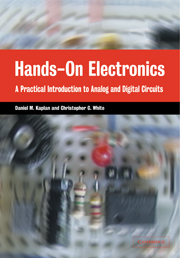Book contents
- Frontmatter
- Contents
- List of figures
- List of tables
- About the authors
- To the Reader
- Acknowledgments
- Introduction
- 1 Equipment familiarization: multimeter, breadboard, and oscilloscope
- 2 RC circuits
- 3 Diodes
- 4 Bipolar transistors
- 5 Transistors II: FETs
- 6 Transistors III: differential amplifier
- 7 Introduction to operational amplifiers
- 8 More op amp applications
- 9 Comparators and oscillators
- 10 Combinational logic
- 11 Flip-flops: saving a logic state
- 12 Monostables, counters, multiplexers, and RAM
- 13 Digital↔analog conversion
- Further reading
- Appendix A Equipment and supplies
- Appendix B Common abbreviations and circuit symbols
- Appendix C RC circuits: frequency-domain analysis
- Appendix D Pinouts
- Glossary of basic electrical and electronic terms
- Index
6 - Transistors III: differential amplifier
Published online by Cambridge University Press: 06 July 2010
- Frontmatter
- Contents
- List of figures
- List of tables
- About the authors
- To the Reader
- Acknowledgments
- Introduction
- 1 Equipment familiarization: multimeter, breadboard, and oscilloscope
- 2 RC circuits
- 3 Diodes
- 4 Bipolar transistors
- 5 Transistors II: FETs
- 6 Transistors III: differential amplifier
- 7 Introduction to operational amplifiers
- 8 More op amp applications
- 9 Comparators and oscillators
- 10 Combinational logic
- 11 Flip-flops: saving a logic state
- 12 Monostables, counters, multiplexers, and RAM
- 13 Digital↔analog conversion
- Further reading
- Appendix A Equipment and supplies
- Appendix B Common abbreviations and circuit symbols
- Appendix C RC circuits: frequency-domain analysis
- Appendix D Pinouts
- Glossary of basic electrical and electronic terms
- Index
Summary
In this chapter we will study the transistor differential-amplifier circuit. This is a very important transistor circuit, as it is the basis of the operational amplifier (or op amp), one of the most useful devices for analog signal processing. Probably the most surprising thing about op amps is their very large voltage gain, usually exceeding 100 000. This chapter will give you a clearer idea how such performance is achieved. We will also look at some other circuits that serve as building blocks for op amps.
Apparatus required
Breadboard, oscilloscope, multimeter, three 2N3904 and three 2N3906 transistors, one 5.1 V Zener diode, three 100 Ω, five 10 k, two 22 k one each of 560 Ω, 2.2 k, and 100 k 14 W resistors.
Differential amplifier
A differential amplifier is an amplifier for differential input signals, i.e. it amplifies the voltage difference of its two inputs. This is useful in two important ways:
A differential amplifier can be used to amplify a differential signal (the voltage difference between the two inputs) while suppressing any noise that is common to the two inputs.
As we will see in future chapters, differential amplifiers make it easy to build circuits that use negative feedback.
Don't confuse the differential amplifier with the differentiator: although the names sound similar, the two circuits perform entirely different operations.
- Type
- Chapter
- Information
- Hands-On ElectronicsA Practical Introduction to Analog and Digital Circuits, pp. 75 - 84Publisher: Cambridge University PressPrint publication year: 2003



